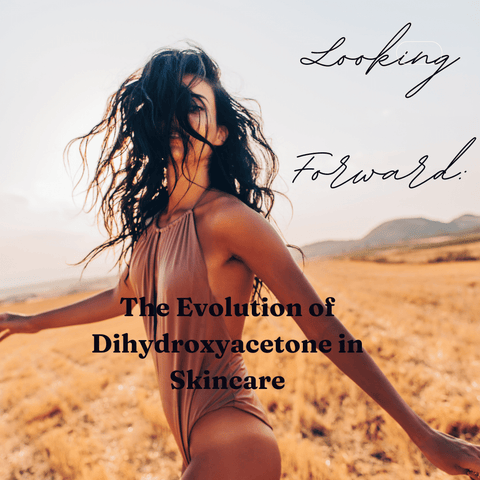Dihydroxyacetone (DHA) is a popular ingredient in sunless tanning products such as lotions, sprays, and mousses. It is in charge of giving the skin a tanned or bronzed appearance without exposing it to UV radiation from the sun or tanning beds. This blog delves more into DHA and its significance in producing sunless radiance.
Understanding Dihydroxyacetone: From Origin to Application

Dihydroxyacetone (DHA) is a chemical molecule used in the cosmetics and skincare industries to tan the skin without exposing it to damaging UV radiation from the sun. Natural sources, chemical structures, reactive qualities, sunless tanning treatments, customisable tanning, tanning booths and sprays, cosmetic bronzers, and combination products are all covered in this detailed study at DHA. Its chemical reaction with amino acids in the skin's outermost layer results in a temporary tan, making it a popular choice for individuals looking for a sun-kissed hue without exposure to the sun. For a natural and even tan, proper application and aftercare are required.
What is Dihydroxyacetone and How Does It Work?
Dihydroxyacetone (DHA) is a colorless chemical molecule that is often used in cosmetics and skincare products to give the skin a tanned or bronzed appearance without exposing the skin to ultraviolet (UV) radiation from the sun or tanning beds. DHA is most commonly found in self-tanning creams, bronzers, lotions, sprays, and other sunless tanning treatments. This reaction produces a sunless tan that may be customised in terms of strength and fades gradually as the skin's outermost layer sheds. For a natural and even sunless tan, proper application and upkeep are required.
A Brief History of DHA in Skincare
In the realm of skincare and cosmetics, dihydroxyacetone (DHA) has a rich history, particularly in the creation of sunless tanning solutions. Here's a quick rundown of DHA's history in skincare, including its discovery and early use (1920s), introduction in the cosmetics industry (1960s), formulation advancements (1980s and 1990s), popularity surge (2000s and beyond), customization and innovation, clean and natural beauty trends, and skincare integration. It has played an important role in providing consumers with a safer and more convenient approach to getting a tan while reducing the hazards associated with UV exposure. The sunless tanning industry is being shaped by ongoing research and innovation, with a focus on providing natural and personalised outcomes.
Popular Products Containing Dihydroxyacetone
Dihydroxyacetone (DHA) is a key component in many sunless tanning and self-tanning products. These products are designed to give the skin a tanned or bronzed appearance without the use of tanning beds or sun exposure. DHA reacts with the amino acids on the skin's surface to produce a temporary tan. Some popular DHA-containing products include self-tanning lotions and creams, self-tanning sprays, self-tanning mousses, self-tanning towelettes or wipes, self-tanning serums and drops, gradual tanning lotions, bronzers, and bronzing powders, professional spray tanning booths, tanning mists, tanning drops for the face, tanning mitts and applicators, and gradual tanning skincare products. It is critical to follow the manufacturer's directions while utilising any DHA-containing product for the greatest benefits. An even and natural-looking tan can be achieved with proper exfoliation prior to application and meticulous application techniques. Additionally, because DHA-based tans do not provide sun protection, it is critical to continue applying sunscreen to protect your skin from UV radiation.
The Beautifying Benefits of Dihydroxyacetone for Skin

Dihydroxyacetone (DHA) has various skin-beautifying properties, especially when employed in sunless tanning and self-tanning treatments. These advantages include a safe tanning option, even skin tone, a natural-looking glow, a customizable tan, a transient effect, a convenient application, a lower risk of sun damage, sunless tanning touch-ups, hydration and skincare benefits, and increased confidence. While DHA has these beautifying properties, correct application and maintenance are essential for attaining the optimum results. Exfoliating the skin prior to application and following the manufacturer's recommendations are critical stages in achieving an even, natural-looking tan. Furthermore, because DHA-based tans do not provide sun protection, it is still required to use sunscreen to protect the skin from UV rays.
Achieving a Natural, Sun-Kissed Glow
A natural, sun-kissed hue can brighten your complexion and give your skin a healthy, beautiful sheen. Exfoliate regularly, choose the right self-tanning product, prepare your skin, use a tanning mitt or gloves, apply in sections, blend well, allow time to dry, avoid water and sweat, maintain your tan, sunscreen and touch-ups, hydrate and eat well, and experiment and practise to achieve this look. Remember that self-tanning is a safe and effective approach to creating a sun-kissed hue without the risk of UV damage. All year long, with correct preparation and application, you can enjoy a natural and luminous tan.
Beyond Tanning: Other Skin Enhancements with DHA
Dihydroxyacetone (DHA), best known for its use in self-tanning products, has also been found to have applications in the skincare and cosmetic industries. Here are some additional skin benefits and applications for DHA:
-
Gradual Tanning and Subtle Glow: DHA is widely used in body lotions, creams, and serums to give a gradual tanning effect. These products allow customers to gradually get a light tan while simultaneously providing hydration and skincare benefits.
-
Face Tanning Drops: Some skincare companies sell DHA-infused tanning drops made exclusively for the face. These drops can be mixed with regular moisturiser or serum to obtain a gradual and customised tan for the face.
-
Body Contouring: DHA-based products can be used to contour the body and give the appearance of more sculpted muscles or a smaller figure. By judiciously using self-tanner to highlight and shadow regions of the body, you can create the appearance of greater definition.
-
Temporary Tattoos and Body Art: DHA-based products can be used to create temporary tattoos and body art. These products allow for artistic designs and patterns on the skin without the permanence of traditional tattoos.
-
Concealing Imperfections: Some people use DHA-containing treatments to mask flaws like scars, stretch marks, or uneven skin tone. You can conceal these regions by gently applying self-tanner to them.
-
Photography and Special Events: DHA-based self-tanners are frequently used to enhance the appearance of the skin in photos and for special events. In photographs, a little tan can make the skin appear healthier and more vibrant.
-
Skincare Products with a Hint of Color: DHA is sometimes added to skincare products such as tinted moisturisers, BB creams, and CC creams to enhance color and shine while still providing skincare advantages.
-
Complexion Correction: Some self-tanning solutions contain color-correcting ingredients that help to neutralise redness or uneven skin tone. These items might help you achieve a more even complexion.
-
Hydration and Moisturization: Moisturising chemicals are frequently found in DHA-based cosmetics, which can help keep the skin moisturised and supple. DHA adds a slight glow while also providing skincare benefits.
-
Preparation for Events: DHA-containing products are sometimes used as a pre-wedding, party, or special occasion preparation step when people wish to have a vibrant and beautiful complexion.
To obtain the intended impact, it is critical to follow the directions supplied by the individual product you are using. Furthermore, while DHA-based treatments can give these benefits, they do not provide UV protection. As a result, it is critical to maintain using sunscreen to protect your skin from UV radiation when you are outside.
Precautions and Considerations for Safe Use
Using Dihydroxyacetone (DHA)-based products for skin enhancements and self-tanning can be safe when done correctly. However, there are some precautions and considerations to keep in mind to ensure safe and effective use:
-
Patch Test: Perform a patch test on a small area of skin before using any DHA-containing product to check for allergies, sensitivities, or adverse reactions. Wait 24 hours before looking for signs of irritation or an allergic reaction.
-
Exfoliation: To achieve a smooth surface, exfoliate your skin before applying self-tanner. Focus on areas with rough skin, like elbows, knees, and ankles, to prevent uneven coloration.
-
Clean Skin: Begin with a clean, dry face. Remove any makeup, lotions, oils, or other products that may obstruct even application.
-
Gloves or Mitts: To apply the product, wear latex gloves or a tanning mitt. This keeps your hands clean and ensures an even application.
-
Avoid Overlapping: When applying the product, avoid overlapping areas as this can cause uneven coloration. Apply self-tanner in sections.
-
Blend Carefully: Pay special attention to areas where colour can accumulate, such as the elbows, knees, ankles, and the backs of the hands and feet. To avoid dark patches, blend these areas thoroughly.
-
Quick Application: To avoid streaking, apply the product quickly. Follow the manufacturer's application technique and timing recommendations.
-
Drying Time: Allow the product to completely dry before dressing. Because drying times vary, be patient and wait for the product to set.
-
Stay Dry: Avoid activities that may cause excessive sweating or contact with water right after applying the tan, as this can affect the evenness of the tan.
-
Hydration: Moisturise on a daily basis to keep your tan from fading unevenly. Choose a hydrating lotion or cream that does not contain ingredients that can degrade DHA.
-
Sunscreen: Use sunscreen whenever you go outside, as DHA-based tans do not provide UV protection. Sunscreen shields your skin from sunburn and damage.
-
Special Areas: Use extreme caution when applying self-tanner to the face, including the hairline and brows. Consider using a product designed specifically for facial use.
-
Storage: Keep DHA-based products in a cool, dry place away from direct sunlight and heat. Check the expiration date on the product and discard it if it has passed.
-
Monitoring Reactions: If you notice any signs of irritation, redness, or itching after applying a self-tanning product, stop using it right away. If necessary, wash off the product and consult a dermatologist.
-
Pregnancy and Nursing: Pregnant and nursing women should seek the advice of a healthcare provider before using self-tanning products containing DHA, as the safety of DHA during pregnancy and breastfeeding is unknown.
-
Allergies and Sensitivities: Before using DHA-based products, consult with a dermatologist or allergist if you have a history of allergies or sensitivities to skincare products.
By taking these precautions and considerations, you can reap the benefits of DHA-based products while reducing the risk of adverse reactions or inconsistent results. Always read and follow the manufacturer's specific product instructions and guidelines.
Mastering the Art of Applying Dihydroxyacetone

It takes practise and attention to detail to master the technique of applying Dihydroxyacetone (DHA) for a beautiful and natural-looking tan. Exfoliation, shower, supplies, tanning mitt or gloves, sectioning, small amounts, beginning at the ankles and feet, legs and knees, thighs and hips, torso, back, arms and hands, face, neck, and décolletage, finishing touches, mirror check, drying time, cleanliness, aftercare, avoiding water, moisturise and sunscreen are all recommended. You may learn the art of applying DHA-based self-tanners for a beautiful and natural-looking tan by following these steps and practising your application technique. Remember that practise makes perfect, so don't give up if it takes a few tries to get the results you want.
Preparation Tips for Best Results
When utilising Dihydroxyacetone (DHA)-based self-tanning solutions, proper preparation is critical for attaining the optimum results. Here are some strategies for achieving a flawless and long-lasting tan:
-
Exfoliation: Begin by thoroughly exfoliating your skin. To exfoliate dead skin cells, use a light exfoliating scrub or mitt, especially in dry regions like the elbows, knees, ankles, and heels. Exfoliation prepares the skin for self-tanning and prevents patchy or uneven coloring.
-
Shaving and Waxing: Before applying self-tanner, shave or wax for at least 24 hours. This causes the pores on the skin to close, lowering the chance of discomfort or uneven color absorption.
-
Shower Before Application: To cleanse your skin and eliminate any residue from skincare products, lotions, oils, or scents, take a warm shower. Before applying self-tanner, make sure your skin is fully dry.
-
Moisturize Dry Areas: Apply a gentle, oil-free moisturiser to dry or rough skin regions, including your elbows, knees, ankles, and the tops of your feet. This aids in the prevention of excessive DHA absorption in certain locations.
-
Remove Makeup: If you're planning to apply self-tanner to your face, remove any makeup before application. A clean, makeup-free face allows for more even color development.
-
Wear Dark, Loose-Fitting Clothing: Wear dark-colored, loose-fitting clothing during and after self-tanning treatment. This helps to avoid stains and allows the self-tanner to dry without rubbing off.
-
Use a Tanning Mitt or Gloves: Wear latex gloves or a tanning mitt when applying self-tanner to avoid staining your hands. These tools aid in the even distribution of the substance and the prevention of uneven color on your palms.
-
Protect Your Hair: If you have light or colored hair, wear a shower cap or tie it up to prevent the self-tanner from accidentally coloring it.
-
Apply Barrier Cream: Some self-tanning products include a barrier cream or lotion to apply to specific regions such as your palms, nails, and foot soles. This keeps these areas from getting too dark.
-
Allow Enough Time: Make sure you have enough time to complete the application process without feeling rushed. Avoid distractions that may result in uneven application.
-
Patch Test: Using a small, inconspicuous area of your skin, perform a patch test to check for any adverse reactions or allergies to the self-tanner. Wait 24 hours before looking for signs of irritation.
By following these preparation tips, you can create an ideal canvas for your self-tanner, resulting in a more even, long-lasting, and natural-looking tan. Preparing your skin properly before self-tanning is essential for getting the best results.
Application Methods and Techniques
Using Dihydroxyacetone (DHA)-based self-tanning solutions to achieve a flawless and natural-looking tan necessitates the proper application methods and procedures. Gather your supplies, exfoliate, and shower, Start with dry skin, apply barrier cream (optional), section your body, apply a small amount, begin at your feet, move to your legs, apply to your torso, address your back, move to your arms, apply to your face, address your neck and décolletage, use a mirror, allow to dry, clean hands, avoid water and sweat, moisturise and maintain, and continue using sunspot preventative measures You may create a gorgeous, even, and natural-looking tan with DHA-based self-tanning products using these application methods and techniques.
Prolonging and Maintaining Your DHA Glow
Maintaining and extending the life of your DHA-based tan necessitates proper aftercare and continuing attention. Moisturising daily, using a gradual tanning product, avoiding hot baths and showers, patting dry after showering, avoiding exfoliating products, skipping chlorine pools, limiting exposure to saltwater, using sunscreen, avoiding tight clothing, touching up as needed, being cautious with facial products, staying hydrated and eating well, reapplying self-tanner as needed, and using tan-enhancing products. You can extend the life of your DHA-based tan and keep it looking attractive and natural by following these steps and practising good skincare habits. Remember that continuous care and attention to your skin are the keys to a long-lasting tan.
Looking Forward: The Evolution of Dihydroxyacetone in Skincare

We can provide some insight into potential future trends and opportunities for DHA in skincare, including advanced formulations, customization, sustainability, health and safety, skincare and wellness integration, improved application techniques, regulatory changes, digital and virtual experiences, and clinical and medical applications. It's critical to remember that the skincare sector is fluid, and customer preferences, market trends, and regulatory environments all shift quickly. Furthermore, consultation with dermatologists or skincare professionals can provide significant insights into the most recent breakthroughs and suggestions for DHA-containing skincare products.















